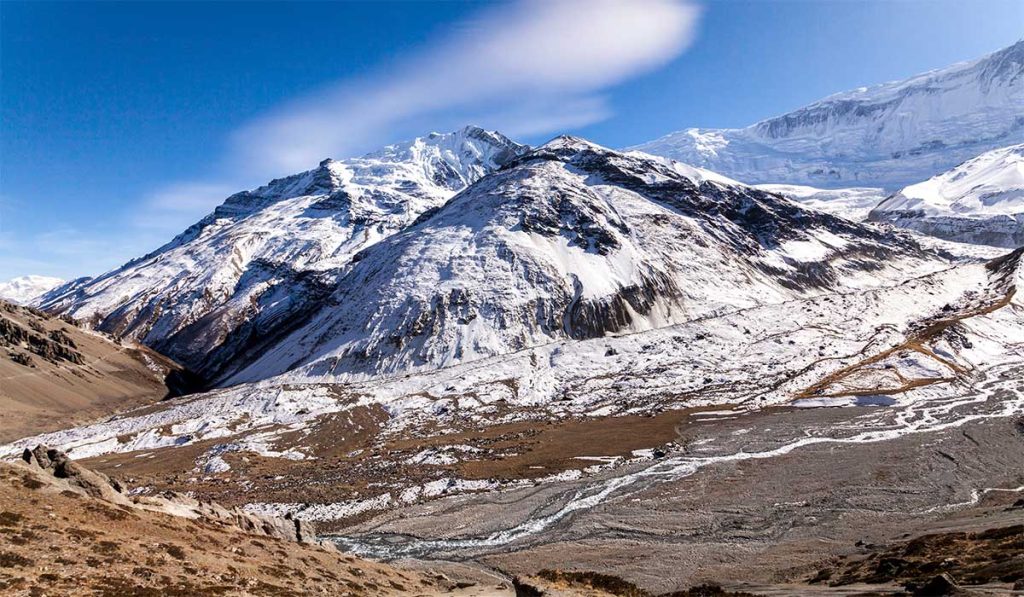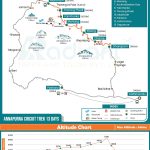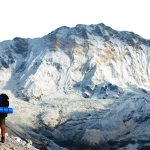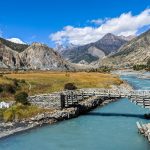November stands out as an exceptional month for the Annapurna Circuit Trek, bringing a deep sense of discovery amidst the majestic Himalayas. Trails lined with golden rhododendron leaves, air carrying crisp chill, distant snow-capped peaks and an azure sky are the highlights of this month. Add to that a chance to immerse oneself in Nepal’s raw natural beauty and cultural tapestry.
The Annapurna Circuit, often hailed as one of the world’s premier trekking routes, encircles the Annapurna massif over a distance of approximately 102 to 230 kilometers. This trek spans 13 days and ascends to a maximum altitude of 5,416 meters at the Thorong La Pass.
In this journey, you traverse diverse landscapes from lush subtropical valleys to arid high-altitude deserts. Cascading waterfalls, terraced farmlands, and ancient monasteries are other things the trekkers encounter en route. All these features in the Circuit in November draw seasoned adventurers and novices alike to its moderately challenging yet rewarding paths.
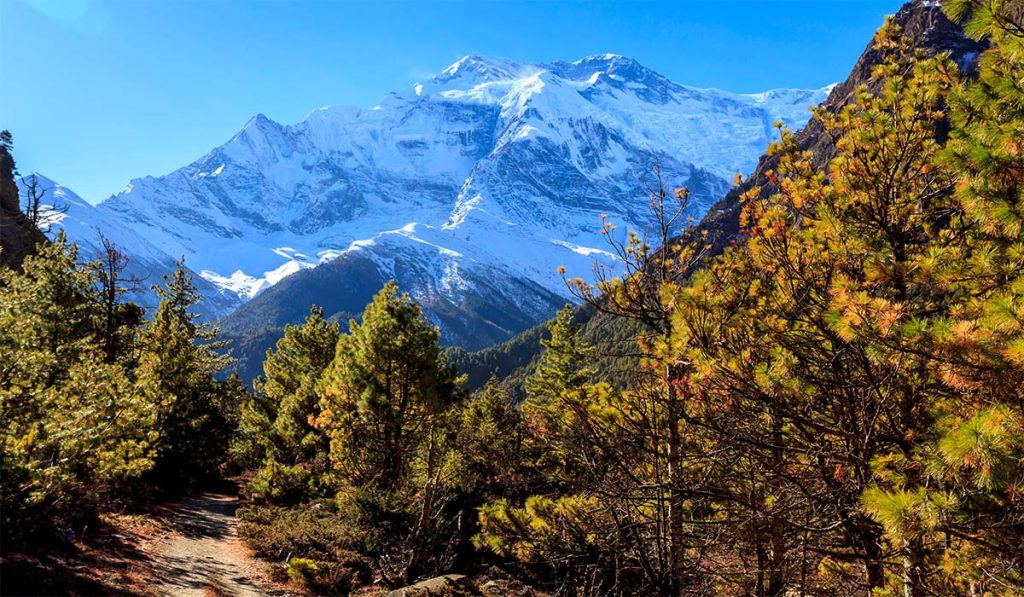
The November trek is unique thanks to its pre-monsoon stability that graces the Annapurna Circuit. The weather is dry and predictable. This offers clear visibility that enhances panoramic views of towering mountains. Likewise, the daytime temperatures are comfortable for trekking. These factors together contribute to trails that remain firm and navigable.
This is that time of the year that is neither too hot nor overwhelmingly cold. Rather, it is ripe with opportunities to witness the Himalayas in their full glory. In addition, you see fewer crowds on the trail during this period as compared to peak October. This allows for more introspective experience amid serene autumn hues.
Whether you are dreaming of solo exploration or a guided group trek, Radiant Treks and Tours is here to ensure you have a smooth experience of the Annapurna Circuit Trek in November.
Highlights
- November weather is pleasant for hiking due to moderate daytime temperatures
- The trekking trails in November are dry and stable, proving favorable for hiking
- The clear blue skies let trekkers enjoy panoramic views of mountains, including Annapurna I, Dhaulagiri and Machhapuchhre
- Air is crisp in November, which optimizes visibility, useful for sightseeing as well as photography
- Thinning crowds in the trails after October means a peaceful trek and easy access to teahouses
- Autumn hues in the lower elevations transform the trails into a carpet of golden leaves
- Chance to witness celebrations of festivals like Tihar in the local communities
Why Trek the Annapurna Circuit in November?
Choosing the November Annapurna Circuit Trek means being a part of a harmonious escapade that blends crisp autumn air, clear views and cultural warmth. Here are some reasons that explain the suitability of the November Annapurna Circuit Trek:

Stable and Clear Weather
November marks the latter part of the autumn season in Nepal. During this period, the monsoon has fully retreated. As such, the precipitation in this month is minimal. The rainfall is often zero throughout the region. The result is dry trails that are free from mud and leeches.
The landscapes look fresh and the air is crisp. This leads to the sharpness of visibility, offering unobstructed views of the Annapurna range, Dhaulagiri and the sacred Machhapuchhre, whose fishtail silhouette dominates local lore.
Are you planning trekking in Nepal? Do you need any information? Let us know via form below, we are happy to help.
Comfortable Temperatures
November weather conditions and temperatures in the Annapurna Circuit vary by altitude. This creates a gradual shift in temperatures that feels manageable as you ascend new elevations every day.
At lower elevations below 2,000 meters, daytime highs range from 15°C to 25°C. This is ideal for steady hiking without excessive sweat.
But as you climb toward Manang and beyond, expect the temperatures to remain between 5°C and 15°C during the day. The nights cool down to 0°C or slightly lower temperatures.
At the trek’s pinnacle, around Thorong La Pass, sub-zero readings are common. Expect the temperatures to dip between -5°C and -10°C after sunset. But these temperatures are manageable if you wear clothes with proper layering.
Rather, this mild chill adds a refreshing edge to your trek, and it is in sharp contrast with the sweltering pre-monsoon heat or winter’s biting frost.

Fewer Crowds, Richer Experience
With the approaching winter, the number of trekkers tends to reduce on the trail since the beginning of November. Fewer trekkers means more solitude on the paths. This fosters your deep connection with the environment as well as the locals. You can see villages buzzing with the cultural vibrancy of the harvest season.
The timing often coincides with festivals like Tihar, one of the important Hindu festivals in Nepal. As such, lights and rituals shine bright in Gurung and Thakali communities during the festive celebrations.
In addition, there is an increase in the sighting of wildlife, too. This is due to the visibility enhanced by the crisp air. As such, November may allow you to see blue sheep grazing on slopes or yaks lumbering across high pastures.
Safer Trails
Monsoon rains cleanse trails, which become firm and stable in November in the Annapurna Circuit. As a result, there is no risk of landslides or slippery trails like in the monsoon and winter. This ultimately makes November one of the safest times to trek the Annapurna Circuit.
Similarly, you do not need to spend your energy worrying about balance when hiking in dry conditions on the trail. Even the steep ascents and descents become more manageable with stable footing. This stability builds confidence for the first-time trekkers. Likewise, the seasoned hikers will be able to cover daily distances without obstacles.
The other thing is the mule trains and yak caravans, which navigate the trails smoothly due to the trails being in good condition. This reduces traffic jams on narrow paths, resulting in a safer and relaxed trekking experience.
Things to Consider
November is not a flawless month. There are certain challenges you may face when trekking to the Annapurna Circuit during this time. One of them is the shorter daylight hours. You are able to trek for around 10 hours every day. This means you need to start trekking early to cover distances safely.
A light snowfall is possible at the high pass towards the end of the month. But the chance is only slight. Yet if it happens, then it makes your trek challenging to an extent. However, it is navigable and often adds a picturesque layer rather than a hindrance to your trek.
Nights can be cold and demand warmer gear. Despite fewer crowds on the trail, popular teahouses might still fill quickly. So, it is a wise move to book a teahouse in advance.
If you choose to trek with Radiant Treks, we can guide you through these challenging yet manageable November trails of the Annapurna Circuit.

Itinerary Outline: Annapurna Circuit Trek in November
- Day 1: Arrival in Kathmandu
- Day 2: Preparation for Trek in Kathmandu
- Day 3: Drive from Kathmandu to Dharapani (860 m / 6,102 ft), Distance 393.4 km, Duration 7 to 8 hours
- Day 4: Trek to Chame from Dharapani (2,670 m / 8,759 ft), Distance 15.7 km, Duration 5 to 6 hours
- Day 5: Trek to Pisang from Chame (3,300 m / 10,826.77 ft), Distance 13.7 km, Duration 5 to 6 hours
- Day 6: Trek to Manang from Pisang (3,540m / 11,614.1 7ft), Distance 17.2 km, Duration 5 to 6 hours
- Day 7: Acclimatization day in Manang
- Day 8: Trek to Yak Kharka from Manang (4,020 m / 13,188 ft), Distance 10.4 km, Duration 4 to 5 hours
- Day 9: Trek to Thorong Phedi from Yak Kharka (4,450 m / 14,599 ft), Distance 7.3 km, Duration 4 to 5 hours
- Day 10: Trek from Throng Phedi to Muktinath (3,800 m / 12,487 ft) via Thorong La Pass (5,416 m / 17,769 ft), Distance 16.4 km, Duration 7 to 8 hours
- Day 11: Visit Muktinath Temple in the Early Morning and Drive to Pokhara
- Day 12: Pokhara to Kathmandu ( Fly or Drive)
- Day 13: Departure from Kathmandu
How November Shapes Your Trek Experience?
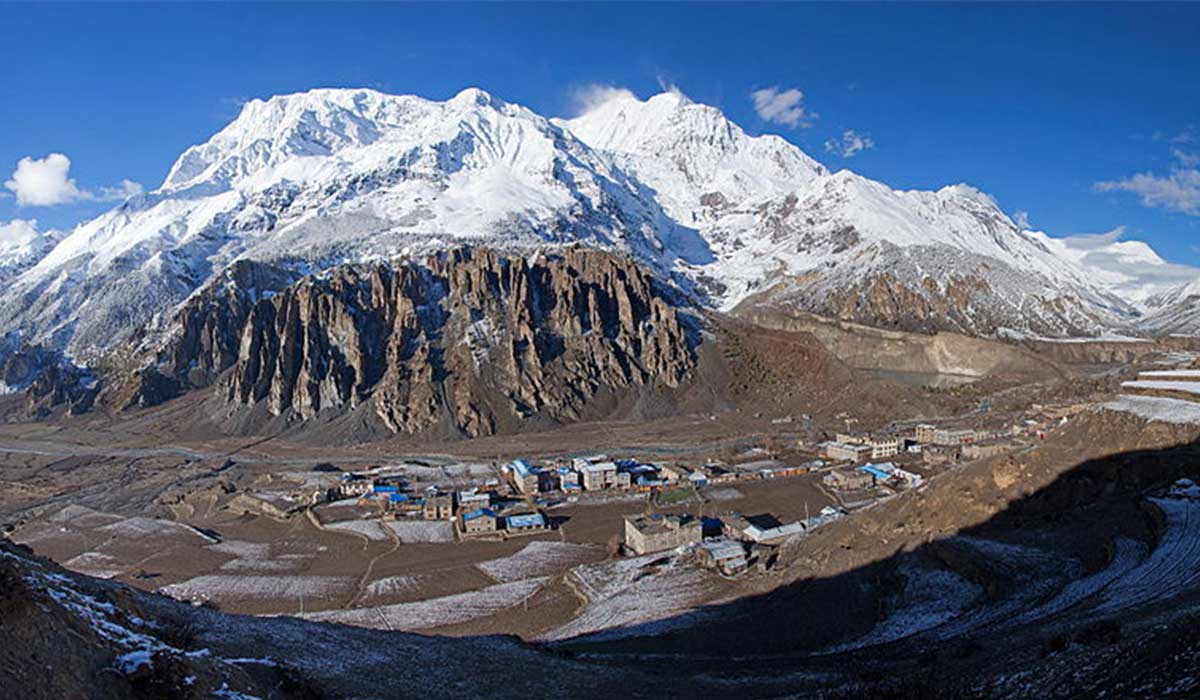
November ushers in a transitional phase for the Annapurna Circuit Trek because it blends autumn’s vibrancy with the onset of winter’s chill. Thus, this time affects your overall trek schedule, requiring you to emphasize strategic pacing, adaptability and safety.
The trek begins with your arrival in Kathmandu and then heading to Besisahar and Chamje, where you can enjoy riverside walks amid subtropical greenery.
The ascent from Chamje to Dharapani along the Marsyandi River through bamboo forests and Gurung villages feels invigorating due to the mild temperatures. You pass through pine groves and apple orchards as you reach Chame. The November harvest might yield fresh fruits from locals while you enjoy views of Lamjung Himal.
Meanwhile, clear November skies allow panoramic views of Annapurna II as you hike to Pisang. The Manang village, with its stone houses and bakeries, offers a glimpse into Tibetan-influenced life. You stay in Manang for one extra day for acclimatization.
Cooler November winds signal higher altitudes as your trek progresses to Yak Kharka. Nevertheless, as the weather is stable in this month, this aids in your trek to Thorong Phedi and the crossing of Thorong La Pass. The same day, you descend to Muktinath. Rewards of the trek include clear and breathtaking views across the Mustang valley.
Descend to Kagbeni to Marpha or Tatopani, and soak in hot springs that soothe the muscles stiffened by the November cold. From there, climb to Ghorepani through rhododendron forests that glow in autumn colors. The sunrise at Poonhill is unforgettable thanks to the clarity of November. Finally, the journey takes you to Nayapul before heading to Pokhara and then returning to Kathmandu. The journey can extend by three more days if you opt for the Annapurna Circuit Trek with Tilicho Lake.
Preparing for November Trek
You must plan properly before initiating the ‘Annapurna Circuit Trek November’. This ensures that you have a safe and enjoyable trek experience. This month demands specific preparations from the trekkers to handle variable weather and the demands of high altitudes. From building physical resilience to assembling the right gear and prioritizing health measures, thorough foresight from your side minimizes the risk of the trek.
Here are some advices that are tailored to November conditions:
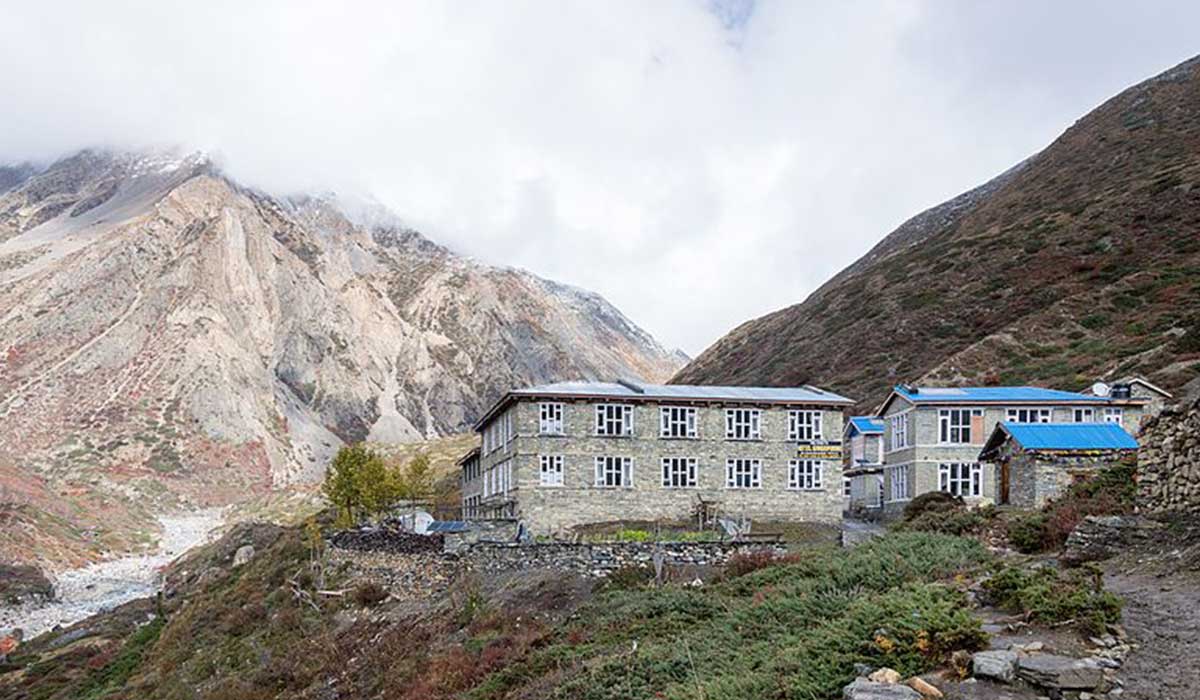
Physical and Mental Preparation
The trekkers must be physically fit to traverse the demanding November terrain of the Annapurna Circuit. That is because the daily hikes can last 6 to 8 hours and involve steep ascents and descents.
For that, begin training at least 4 to 8 weeks in advance. Activities like running, cycling and swimming boost your stamina.
Include strength training such as squats and lunges for leg power. Likewise, go on a hike with a weighted backpack to simulate trail conditions. In addition, you should aim for progressive intensity — start with shorter outings and gradually increase the distance and elevation of hikes.
It prepares your body for physical strain. You are also accustomed to carrying loads in cooler November air. Eventually, it reduces the likelihood of fatigue or injury. But if you have pre-existing health conditions, consult a healthcare professional before starting physical training.
Mental preparation by a trekker is also important when on the November Annapurna Circuit Trek. You need to be resilient and patient to face longer days of trekking. Likewise, those qualities are essential to deal with changing weather conditions and other challenges of November.
You should learn to practice mindfulness in order to be mentally ready for the journey. Visualization of daily progress can prevent you from being demotivated. And set small goals, as they can make the trek seem possible to conquer.
Trek Permit
Obtaining a permit for the Annapurna Circuit Trek in November is easy when it is handled through an agency experienced in this aspect. It helps you streamline the process and ensure compliance with Nepal’s regulations.
This trek requires you to obtain the Annapurna Conservation Area Permit. As November follows the peak trekking month of October, there is a chance that relatively more trekkers will be opting for this journey. Therefore, it is advised to secure the permit early to avoid delay in obtaining it.
The permit can be obtained through Kathmandu or Pokhara. Radiant Treks can manage the paperwork for you so that you can solely focus on the adventure.
Packing Essentials
The success of the Annapurna Circuit Trek in November largely depends on your packing strategy. The principle of layering system to adapt to November’s fluctuating temperatures is one of the important factors in this.
Continue to read to understand the essentials you should pack for this trip:

Clothing
- Thermal base layers (tops and bottoms): Carry 2-3 sets in merino or synthetic materials to manage sweat and stay warm without bulk.
- Fleece mid-layer: Add something zippy for easy venting on warmer stretches.
- Down jacket: It is a lifesaver at night, especially at high altitudes. The synthetic fills are a good choice if you’re worried about the jacket getting wet due to sweat.
- Waterproof shell jacket and pants: Opt for breathable Gore-Tex material as they keep you dry.
- Trekking pants: Pack a pair of lightweight pants for lower elevations and an insulated pair for cold weather.
- Wool socks: Socks with liners can prevent blisters.
- Gloves: A waterproof outer pair of gloves shields your hands from winds.
- Hat or beanie: Wool or fleece is useful in extreme temperatures. A buff or neck gaiter protects from dust and provides extra warmth.
Footwear
- Hiking boots: Bring along broken-in boots with solid ankle support and waterproofing to tackle rocks and streams.
- Camp shoes or sandals: Buy lightweight options like Crocs, as they give your feet a break and keep things clean.
Gear
- A 40-50L backpack with a good hip belt and rain cover distributes weight properly. Look for one with compartments to stay organized.
- Your sleeping bag needs a -10°C rating. Opt for mummy style in down or synthetic material, and throw in a liner for extra coziness.
- Pack adjustable trekking poles as they ease the strain on your knees when you descend.
- Bring a headlamp with spare batteries for those early November starts.
- Get an insulated water bottle of 1-2L as it keeps drinks from freezing.
- UV sunglasses shield you against that intense high-altitude glare.
Health / Essentials
- A first-aid kit with Diamox for warding off altitude woes
- Painkillers like ibuprofen, bandages, blister plasters and antiseptics.
- Personal medications
- Sunscreen with SPF 50 or more and lip balm are a must
- Stock energy bars or gels as well as nuts for snacks.
- Keep the basics of toiletries like biodegradable soap, toothbrush, wet wipes and sanitizer in a small pouch
- A multi-tool, earplugs for noisy nights, and duct tape for quick fixes are useful
November-Specific Additions
The nights can get extremely cold in November in the Annapurna Circuit. Plus, the rare chance of a light dusting of snow in the month adds to the challenges. Shorter days mean you’re hustling more in the light you’ve got. So, gear up with extras that boost safety and ease without weighing you down.
For traction on slick spots — like frosty bits around Thorong La — micro-crampons or ice grips are a smart addition. They’re these stretchy spike things that fit over your boots and pack tiny. They are not always essential early in the month, but better safe if you’re going late.
Power can be spotty in those remote teahouses, so a portable solar charger (at least 10,000 mAh) with cables keeps your phone or camera alive for maps or photos.
To fight the deeper cold, toss in extra sleeping bag liners (fleece or silk for the warmth). The chemical hand and foot warmers are also useful. They’re cheap and light as well.
A glacier-style pair of sunglasses amps up eye protection if snow glare kicks in, and an emergency blanket is a lightweight backup for any holdups.

Health and Safety Tips
Be it the Annapurna Circuit Trek in November or any other high-altitude trek, health should always be your priority. That is because acute mountain sickness (AMS) poses a real threat in such areas.
To prevent this condition from affecting you, drink 3-5 liters of water daily. And use purification tablets or filters to make the water safe for drinking.
Likewise, ascend gradually, adhering to the acclimatization days of your itinerary. Do not forget to monitor symptoms like headaches, nausea, or dizziness. Experiencing those symptoms means you might have been affected by the AMS. If they arise, descend immediately and seek medical help.
You can start using Diamox a day before ascending above 3,000 meters after consulting your doctor. This medicine helps prevent AMS to an extent. Also, you must have travel insurance that covers high altitude evacuation. Maintain good hygiene to prevent gastrointestinal issues.
Wrapping It Up
As you wrap up your plans for the Annapurna Circuit Trek, November emerges as that sweet spot where the Himalayas truly shine. The crisp air sharpens every view that comes before you. Likewise, beautiful autumn hues enhance your trek experience and quiet trails let you connect deeply with nature.
You will need good preparation to deal with the chill and challenges of the Thorong La Pass. The effort to reach the high pass is rewarding because upon reaching there, you get some of the most spectacular views of Dhaulagiri and the surrounding mountain ranges.
At Radiant Treks, we have guided a number of adventurers through this journey. We are experts in handling the nitty-gritty so that they can savor every step of the trek. If you also want a similar experience, don’t let the season slip by and book our package.

FAQs
Is November safe for the Annapurna Circuit Trek?
Yes, it’s generally safe because November is known for stable and dry weather. It reduces the risks of landslides. Though monitor for rare late-month snow at Thorong La Pass.
What is the temperature like in November in the Annapurna Circuit?
Daytime highs range from 15-25°C in lowlands. They are between 5°C and 15°C in mid-elevations. The temperatures at night can drop to -5°C to -10°C above 4,000 meters.
How do shorter days in November affect the itinerary?
The daylight is there for some 10-11 hours. So, you should start your hikes at dawn to cover distances safely. Incorporating flexible breaks and early arrivals at teahouses avoids trekking in the dark.
Are the trails crowded in November on the Annapurna Circuit?
No, crowds thin out after October. So, you can expect solitude on trails. As such, you have a more relaxed and personal experience amid the autumn scenery.
What wildlife can I expect to see in November?
Clearer skies enhance sightings of yaks grazing near Yak Kharka, blue sheep on slopes, and birds like Himalayan griffons, especially in the alpine zones.
Is a special gear required for the November trek?
Include micro crampons for trekking on the trails that might turn icy due to potential snow late in the month. Pack extra thermals for cold snaps and a headlamp for shorter days to ensure safety.
How does November enhance cultural experiences?
November coincides with the harvest season in Nepal. At the same time, you might also witness the celebration of the Tihar festival. Along with that, you can interact with locals and visit the monasteries of the region.
What health precautions are important for the November trekking?
Follow the rules of acclimatization. Drink water and hydrate sufficiently. Carry insurance for evacuation in case of any health emergency.
Trips you may like:
Annapurna Base Camp Trek 12 Days
Annapurna Khayer Lake Trekking 14 Days
21 Days Annapurna Circuit Trek with Tilicho Lake

